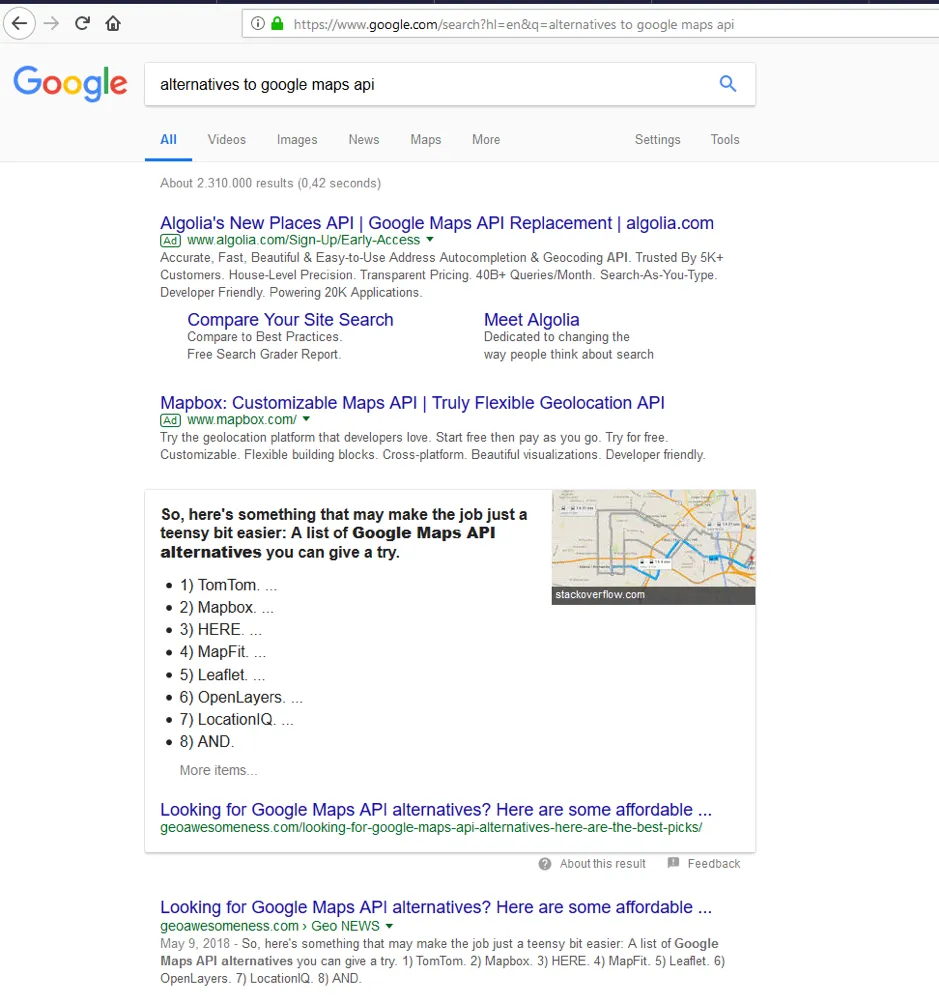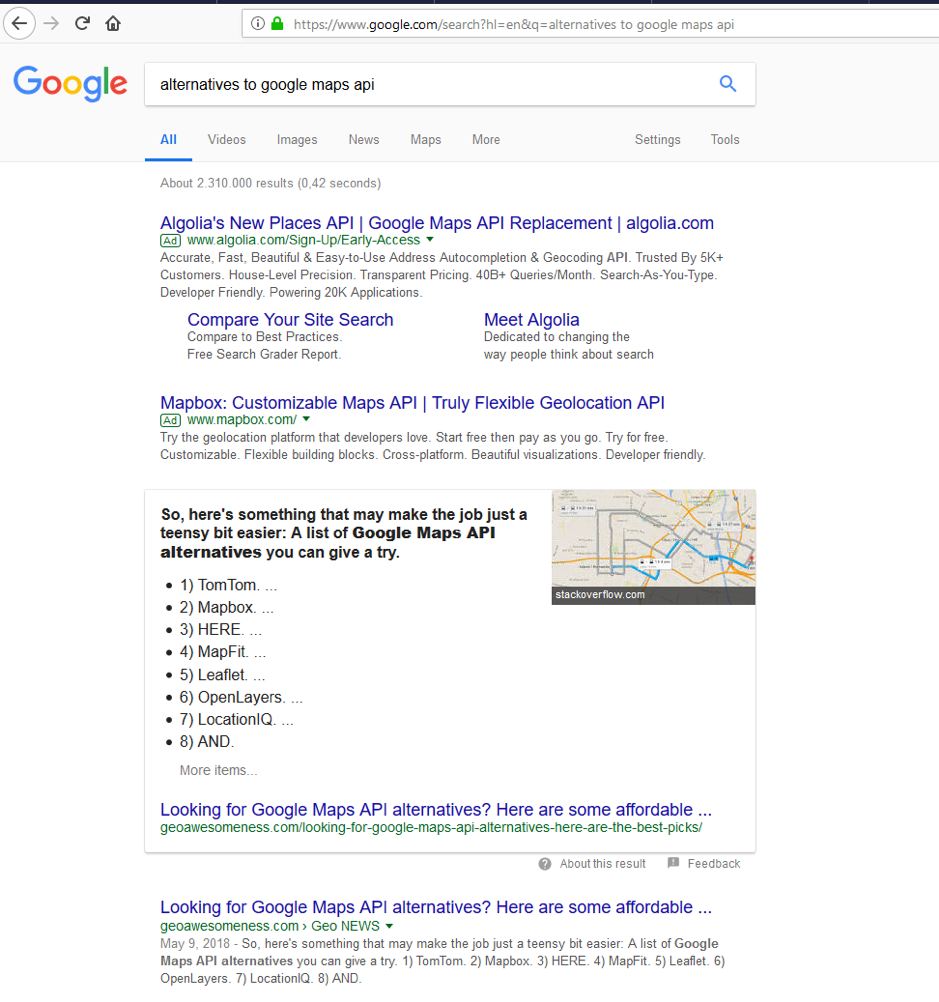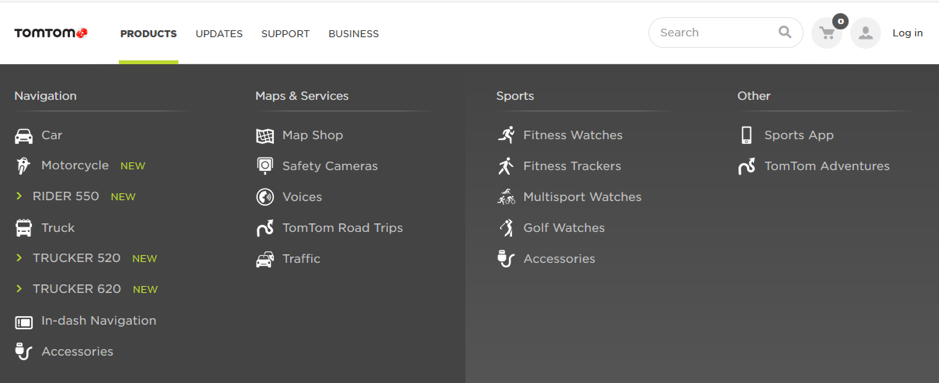
All you need to know about TomTom’s Mapping APIs
With the recent change in the Google Maps API pricing structure, the industry is abuzz with developers and industry professionals weighing in on alternatives to google maps and their pros and cons. At Geoawesomeness, we created our own list of alternatives to Google Maps, which much to our delight is ranked quite high on Google search. (Read: Looking for Google Maps API alternatives? Here are some affordable ones). In order to expand this article and provide everyone with a better understanding of the alternatives, we spoke to TomTom’s head of developer relations, Gregory De Jans. Read on!

Q: Gregory, thanks for taking the time to talk to us! Let’s get started! TomTom is synonymous with Maps and Personal Navigation Devices (PND) but not many know that TomTom also has quite a few APIs that help developers build location-based apps… Perhaps it’s not surprising considering that TomTom’s product page doesn’t list it! (see screenshot)

(i) Are APIs a new business area at TomTom?
A: APIs are a relatively new business area and an area of growth for TomTom. TomTom has been developing Location Bases Services APIs for several years but only since the end of last year, we started offering our APIs to businesses of all sizes to help fuel growth for developers at any scale.
(ii) What is your vision for the APIs market?
A: With the convergence of offline and online, location information has become more critical than ever. New players are entering the market very aggressively and existing players are frequently changing their business models. Maps APIs are already required in many existing use cases like IoT, fleet & logistics and on-demand. But many new use-cases like smart cities, geospatial data analytics and Augmented Reality are also empowered by Maps APIs which makes it a rapidly growing and interesting market which that will keep on growing significantly over the next couple of years.
Q: Before you dive deeper into the TomTom API, let us address the “elephant in the room” – what’s your opinion about Google Maps recent pricing changes? More specifically, are you being approached more by startups looking for a “cheaper” alternative or has it been more the enterprise customers who have approached TomTom?
A: The recent Google price changes have indeed led to a lot of Google Maps customers looking for more affordable alternatives. TomTom has seen double-digit growth in the percentage of visitors to the developer portal, users of our APIs and questions from customers looking to migrate from Google Maps APIs to TomTom Maps APIs. Because of that, we have created tutorials on how customers can easily migrate from the Google Maps SDKs to the TomTom Maps SDK on web and mobile. All of these materials are available on our developer portal at developer.tomtom.com
We have been approached by both startups and enterprises. For the startups who were not paying much to Google before and now get invoices for thousands of dollars, the impact is, of course, the heaviest, so we did see a more immediate and urgent request for affordable alternatives there.
As of this week, we have also announced that we will be giving away our maps and traffic flow tiles away for free in our Mobile Maps SDK for both Android and iOS. We’re trying to make it as easy as possible for startups to get started without having to worry about the heavy costs to build applications.
Q: Could you tell us a bit more about your pricing structure, as well as other value-added benefits and how your approach differs from the competition?
A: We have made our maps and traffic flow tiles on mobile free. This means that it will be entirely free for developers to display maps and traffic flow inside a mobile application using the TomTom Mobile SDK for iOS and/or Android. With free maps, developers can add location in their application without having to worry about costs. An example is a simple store locator where you want to display the location of your business on a map. This will be entirely free using the TomTom Maps Mobile SDK. Moreover, TomTom is the only provider to offer free traffic tiles. This means that developers can also benefit from high-quality traffic information and develop innovative mobile applications for free.
Outside of the free map and traffic flow tiles in our Mobile Maps SDK, The TomTom Maps API pricing structure is transactional, meaning we only charge our customers for the API transactions they consume, without any additional subscription fees. The TomTom Maps APIs can be used for free if the transaction volume does not exceed 2,500 transactions per day. When customers want to consume more than those 2,500 transactions per day, they can purchase small or large packages of TomTom credits which are valid for 1 year. In our public pricing model, the smallest package of 50k credits costs $25 (meaning $0,50 per 1000 transactions). When a customer purchases larger packages, he even gets discounts which make the price per 1000 transactions more attractive and lower than $0,50.
We are mainly differentiating from the online pricing models from our competition by:
- Giving our maps and traffic flow tiles for free in our Mobile Maps SDKs
- Providing evaluating customers to access all our TomTom Maps APIs and SDKs
- Offering discounts when purchasing larger credit packages
- Allowing customers to mix and match our Maps APIs with other APIs
- Allowing additional use cases such as asset management
- Providing personalized support to all our developers, whether they are using our APIs for free or paying.
Q: A developer in the mapping industry certainly has no dearth of choices. In your opinion, why should one use the TomTom APIs instead of the other options? Why do you think TomTom should be the first choice (besides pricing and good map coverage)?
A: The TomTom Maps APIs can serve many use cases but they have been designed to specifically implement applications for use cases within the mobility, fleet & logistics and IoT industries. For any application where you need to know how to get somewhere and when you will get there, the TomTom Routing and Traffic APIs are second to none in quality. So in addition to fair pricing as your business grows, you get the best solution in the market with the accuracy and precision you need.
To allow our customers to be successful in those markets, TomTom has heavily invested in its technology:
- Our transactional map-making platform is allowing us to provide our customers with the freshest maps. We’re currently doing 1.5bn map updates per month which is really impressive but at the same time also mandatory to reflect the changes which are taking place in real-time. This technology is reflected in the high quality and precision of our geocoding and map display APIs.
- Our traffic fusion engine is allowing us to offer predictive, real-time and historical traffic information in our routing and traffic APIs. By using this technology our customers can calculate the most up-to-date and accurate travel times and itineraries.
Q: Your announcement offering free mobile maps SDK is exciting news for a lot of developers. What lead to this decision and what kind of impact do you think it will have?
A: TomTom has been in the mapping space for over 26 years and till this day we’re trying to keep the world and the people in it moving whether it be physically from one place to the next or helping businesses advance in technologies. There are plenty of waves in new technologies that are demanding location technologies today and we knew we wanted to not only work with large companies, but also developers who are just starting out. To do this, we wanted to not only make our products as easily accessible as possible, but also our pricing. It is important for us to listen to our developer community on the challenges they’re facing and how we can best help them in building the next generation of applications. Thus, when we gathered input on the challenges and heavy burden developers/businesses were facing in getting access to reliable map tiles at little to no cost, we knew we had to do something about this.
Q: The “Audio Traffic” API where the driver gets (audio) traffic updates sounds like something that Radio stations provide.. If you don’t mind us asking, could you perhaps give us more information about its target audience and applications where it is currently being used?
A: The Audio Traffic API is allowing developers to create applications which offer personalized traffic information. Radio stations are broadcasting traffic information to everyone in the area but a lot of that information is not relevant for the itineraries of those drivers. By using the Audio Traffic API, for example, music streaming apps can offer personalized traffic information for each driver while they are listening to their favorite music. This is not only allowing them to offer their end-users personalized music but also personalized traffic information during their itinerary.
Q: One of the APIs/Service that caught my attention when browsing through your offering was the “Matrix Routing” service that is part of the Online routing API (if I am right). This seems like an useful service for ride-sharing applications, logistics companies. Could you tell us more about this service?
A: This is correct. The Matrix routing API allows developers to calculate travel times, distances and delays between multiple origins and destinations by doing only 1 API call. By using this API, you can for example implement the following use-cases:
- Select the most appropriate taxi for picking up a passenger, taking real-time traffic conditions into account
- Highlight to a user where the closest Starbucks or ATM is.
- Calculate which trucks should pick up and deliver what goods to serve all their clients in the fastest way.
Q: TomTom has been around for almost 3 decades now and your maps are used by Microsoft as part of their Azure platform, by Apple in their maps. Some of your customers (read Microsoft) also have their own mapping APIs. Do you see this as a competition? What is your take on this?
A: Microsoft is a strong partner to TomTom who has a large community of Azure users/developers. Because of this, Microsoft is actually helping TomTom on our mission to have our APIs and technology adopted by as many developers as possible.
Q: More and more startups have begun to see opportunities in using location data and APIs in building their services/products. As the head of dev relations, are startups an area of focus for your team? Is there something specific that you would like to convey to startups?
A: Our entire online pricing model is actually put in place to allow startups to use our Maps APIs in an affordable way. Startups all have 1 thing in common: they want to grow and make money. By offering our Maps APIs for free up to 2,500 transactions per day, we allow startups to use our APIs for free, even commercially, when they are still in an early stage. When they grow and their applications become more widely used, they can select a package of the right size for them. So our online pricing model is actually allowing startups to grow at their own pace without any lock-ins.
Q: Another area where TomTom faces intense competition is HD Maps (Maps for autonomous driving). Considering that the German car industry has heavily invested in HERE and not many automakers are rumored to be interested in working with Google that leaves TomTom as the “only” global player.
A: The winner in the HD Maps space will be the company that can offer a complete mapping system delivering highly accurate, quickly updated HD Maps on a global scale. Our expertise in map-making, map delivery and map maintenance – together with our network of partners – puts us in a great competitive position to do just that.
Q: Any updates on your partnership with Microsoft and Esri? (link)
A: After 6 months of public preview, Microsoft has announced the general availability of Azure Maps in May this year. We have been working with Microsoft to make more and more innovative services available on the Azure platform, such as Matrix Routing or Route Ranges (link). We are very proud to be working with Microsoft to make great location technology available to Azure developers.
Q: How do you think this space is going to evolve?
A: TomTom is the global, independent location expert. This puts us in a position to work with an array of different companies, from large to startup and help everyone on their growth journey. HD Maps and connected cars go beyond cars driving themselves to cars talking to buildings and smart cities to create a connected ecosystem: IoT to the max. TomTom is uniquely positioned to capture these opportunities and enable the companies fulfilling these use cases.
Q: Any closing remarks that you would like to share with our readers?
A: I would like to encourage customers, who are impacted by the Google Maps price changes, to go to our developer portal (developer.tomtom.com) and evaluate our Maps APIs and SDKs for free. TomTom offers high quality and accurate mapping, geocoding, routing and traffic APIs at an affordable price. If there would be any further questions, we’re offering both technical and commercial support via our contact-us page to all developers (free and paying).





